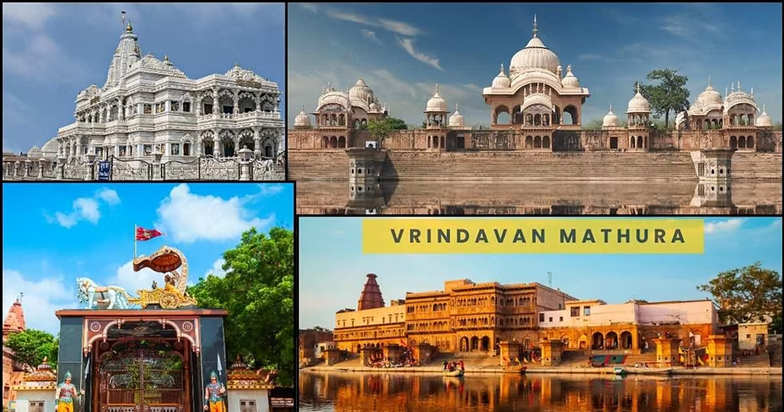Nestled along the sacred banks of the Yamuna River in Uttar Pradesh and its best place to visit in Uttar Pradesh, Vrindavan beckons to pilgrims and curious travelers alike. This ancient town, steeped in mythology and devotion, is widely revered as the very playground where Lord Krishna spent his blissful childhood, performing countless divine pastimes. Every winding lane, every ancient tree, and every echoing chant in Vrindavan breathes tales of Krishna’s miracles, making it an unparalleled destination for spiritual seekers and those simply looking to immerse themselves in India’s rich cultural tapestry. In 2025, Vrindavan continues to be a magnetic spiritual destination, drawing millions from across the globe, offering a profound journey into devotion, history, and vibrant traditions.
This ultimate guide will take you through the top reasons why Vrindavan should be on your travel list, detailing the must-visit temples, the best times to experience its charm, and essential travel tips for a truly seamless and unforgettable journey to the heart of Krishna’s land.
Top 5 Must-Visit Temples and Spiritual Sites
Vrindavan is often called the “City of Temples,” with estimates of over 5,000 shrines dedicated to various aspects of Krishna and Radha’s divine love. While each holds its unique charm, some stand out for their historical significance, architectural grandeur, and spiritual ambiance.
Prem Mandir: The Temple of Divine Love
A relatively recent addition to Vrindavan’s spiritual landscape, Prem Mandir, meaning “Temple of Divine Love,” is a breathtaking sight. Constructed entirely of white Italian marble, its intricate carvings depict the pastimes of Radha Krishna and Sita Ram, showcasing exquisite artistry. The temple complex is expansive, featuring beautiful gardens, fountains, and magnificent dioramas that narrate episodes from Krishna’s life.
Significance: Dedicated to Radha Krishna and Sita Ram, Prem Mandir serves as a modern symbol of eternal love and devotion. It’s a testament to the enduring power of Bhakti (devotion).
Best Time to Visit: While beautiful throughout the day, the evening is highly recommended for its spectacular light and sound show, which illuminates the temple in a dazzling array of colors, narrating stories in a mesmerizing display.
Banke Bihari Mandir: Vrindavan’s Beating Heart
No visit to Vrindavan is complete without experiencing the intense devotional energy of the Banke Bihari Mandir. Built in the 19th century, this temple houses the mesmerizing swaying idol of Banke Bihari (Krishna in his most charming form). What makes darshan here unique is the tradition of drawing a curtain every few minutes before the deity. Devotees believe that direct and prolonged eye contact with the idol can be overwhelming, causing one to lose themselves in spiritual ecstasy.
Significance: This temple is central to Vrindavan’s spiritual identity, with its unique darshan style and the profound emotional connection devotees feel with the deity.
Best Time to Visit: Early morning for the Mangala Aarti, though expect large crowds. The temple’s energy is palpable throughout the day.
ISKCON Vrindavan (Sri Krishna Balaram Mandir): A Global Hub
The International Society for Krishna Consciousness (ISKCON) temple, also known as Sri Krishna Balaram Mandir, is a global spiritual hub that attracts devotees from all corners of the world. Founded by A.C. Bhaktivedanta Swami Prabhupada in 1975, the temple complex is meticulously maintained, offering a serene atmosphere amidst vibrant kirtans (devotional chanting).
Significance: ISKCON Vrindavan plays a crucial role in promoting Krishna consciousness worldwide. It offers a structured and welcoming environment for spiritual learning and practice.
Activities: Visitors can participate in daily aartis, listen to soul-stirring bhajans, and attend discourses on Vedic scriptures. The complex also has a guesthouse and a renowned vegetarian restaurant.
Radha Raman Temple: A Self-Manifested Deity
The Radha Raman Temple is a revered historic shrine known for its unique deity of Lord Krishna, believed to have self-manifested from a shalagrama shila (sacred stone). Built in 1542 by Gopala Bhatta Goswami, one of the six Goswamis of Vrindavan, the temple holds immense importance for followers of Gaudiya Vaishnavism.
Significance: The self-manifested deity makes this temple exceptionally sacred. Its traditional ambiance offers a profound sense of peace and connection to ancient spiritual lineages.
Ambiance: Unlike some larger, bustling temples, Radha Raman Temple provides a more intimate and traditional worship experience.
Nidhivan: The Mystical Grove
Nidhivan is a dense, enigmatic grove in Vrindavan, characterized by its twisted trees whose branches are believed to be Gopis (cowherd girls) who partake in the divine Ras Leela with Radha and Krishna every night. Visitors are strictly prohibited from entering the grove after sunset due to the pervasive belief in these nightly divine pastimes.
Significance: Nidhivan is shrouded in mysticism and deeply ingrained in the local folklore surrounding Lord Krishna’s nocturnal activities with Radha and the Gopis.
Experience: The unique appearance of the trees and the profound spiritual tales associated with them make Nidhivan a captivating and slightly eerie place to visit during the day.
Other Significant Places and Experiences
Beyond these five prominent sites, Vrindavan offers a plethora of other sacred spots and cultural experiences that enrich any visit:
- Keshi Ghat: Located on the banks of the Yamuna River, Keshi Ghat is a tranquil spot perfect for evening aartis where hundreds of lamps float across the river, creating a mesmerizing spectacle. Boat rides are also popular here, offering a unique perspective of the ghats.
- Seva Kunj: Another beautiful grove associated with Radha and Krishna’s pastimes, particularly their playful activities and rest after the Ras Leela.
- Shri Rangnath Ji Mandir (Rangji Temple): This is the largest temple in Vrindavan, built in 1851 in the South Indian Dravidian architectural style. Its impressive seven-story gopuram (gateway tower) and a 50-foot-high gold-plated pillar (Dhwaja Stambha) in the inner courtyard are remarkable.
- Madan Mohan Temple: One of the oldest temples in Vrindavan, offering a glimpse into the town’s historical and spiritual evolution.
- Vrindavan Parikrama: For those seeking a deeper spiritual immersion, the Vrindavan Parikrama is a 13-kilometer spiritual circumambulation of the town, undertaken by devotees to absorb the divine energy of Vrindavan.
- Loi Bazaar: A bustling local market where you can find devotional items, traditional Indian handicrafts, clothing, and various souvenirs.
Best Time to Visit Vrindavan
Choosing the right time to visit Vrindavan can significantly enhance your experience, balancing pleasant weather with crowd levels and festival vibrancy.
- Peak Season (October to March): This is by far the most popular time to visit. The weather is pleasant, with temperatures ranging from a comfortable 10°C to 28°C. This period is ideal for sightseeing and exploring the numerous temples without the discomfort of extreme heat or rain. It also coincides with many vibrant festivals like Diwali, Holi (though extremely crowded, offering a unique experience), and Janmashtami (Lord Krishna’s birthday). Be sure to book accommodations well in advance if visiting during these festivals as prices surge and availability becomes scarce.
- Moderate Season (April to June): The summer months bring hot weather, with temperatures soaring between 25°C and 45°C. While less crowded, making for a more peaceful visit, the intense heat can be challenging for extensive outdoor exploration. Mornings and evenings might still be relatively comfortable for temple visits. Accommodation discounts are more common during this period.
- Off-Season (July to September – Monsoon): Vrindavan experiences moderate to heavy rainfall during the monsoon season. While outdoor activities might be limited, the rain transforms the landscape into lush greenery, offering a serene and beautiful ambiance. Temperatures range from 20°C to 35°C, making it a humid but cooler time. This is also an excellent time for budget-conscious travelers seeking discounts on hotels and a more tranquil atmosphere.
Important Note: If your primary aim is to experience major festivals like Holi or Janmashtami, be prepared for immense crowds and pre-book everything. For a more peaceful and contemplative visit, consider non-festival times within the peak or off-peak seasons.
Travel Tips:
To ensure a comfortable and spiritually enriching trip to Vrindavan, keep these practical tips in mind:
- Accommodation: Vrindavan offers a range of options, from budget-friendly dharamshalas (pilgrim rest houses) and ashrams to mid-range and luxury hotels. Booking well in advance, especially during the peak season or festivals, is highly recommended to secure your preferred stay and avoid inflated prices. Ashrams like the ISKCON Guesthouse offer a unique spiritual immersion.
- Local Transport: The narrow, bustling lanes of Vrindavan are best navigated using e-rickshaws and cycle rickshaws. They are convenient, affordable, and readily available. Always negotiate the fare before starting your journey. For exploring the inner alleys and experiencing the true essence of Vrindavan, walking is often the best option. For longer distances or group travel, auto-rickshaws or pre-booked private cabs can be considered.
- Food: Vrindavan’s cuisine is strictly pure vegetarian (sattvic), reflecting its spiritual nature. Be sure to try the local milk-based delicacies like lassi, peda, and rabri. Stick to clean, well-known restaurants or ashrams that maintain good hygiene. While street food can be tempting (samosas, jalebis, aloo tikki, pani puri), exercise caution and choose vendors with a steady stream of customers and clean preparation areas. Always opt for bottled or boiled water.
- Dress Code: Given the town’s religious significance, modest attire is highly recommended, especially when visiting temples. For women, this typically means covering shoulders and knees; carrying a scarf or dupatta to cover the head inside temples is also advisable. Men should also opt for modest clothing like shirts and trousers or traditional Indian wear. Avoid shorts, sleeveless tops, or overly revealing clothing.
- Safety:
- Monkeys: Vrindavan is notorious for its mischievous monkeys. Be extremely vigilant, as they are known to snatch glasses, food items, and mobile phones. Do not provoke them. If an item is snatched, locals sometimes suggest offering a small food item (like a Frooti packet) to get it back, but it’s best to avoid such situations entirely by keeping belongings secure.
- Pickpockets: In crowded areas, especially around major temples and markets, be wary of pickpockets. Keep your wallets in inner pockets and bags securely zipped.
- Water: Only drink bottled or properly filtered/boiled water to avoid stomach issues.
- Touts and Guides: Be cautious of unauthorized guides or touts offering “special” entry or quick tours. It’s advisable to pre-book tours through reputable agencies or rely on information from your accommodation. Temple entry is free, so beware of anyone demanding payment for darshan.
- General Safety: Carry a copy of your ID, essential medications, and a power bank for your phone. Share your itinerary with a family member or friend back home. It’s generally recommended to avoid isolated areas after dark.
Vrindavan’s Spiritual Essence & Culture
Vrindavan is more than just a collection of temples; it’s a living spiritual experience. It’s part of the sacred Braj region, the land associated with Lord Krishna’s divine play. The common greeting “Radhe Radhe” echoes through its streets, signifying the paramount devotion to Radha, Krishna’s beloved consort.
The town is a vibrant hub of devotional activities, from spontaneous kirtans breaking out in narrow alleys to elaborate Ras Leela performances that reenact Krishna’s divine dance with the gopis. Traditional arts like Sanjhi (paper cutting art) also flourish here. While Vrindavan is also known as the “City of Widows,” reflecting a historical social aspect, its primary identity remains its profound spiritual connection to Lord Krishna.
Conclusion
A visit to Vrindavan is more than just a trip; it’s a profound spiritual journey that can deeply touch the soul. It offers a unique blend of ancient history, vibrant culture, and an overwhelming sense of devotion that permeates every aspect of life here. From the architectural marvels of Prem Mandir to the ancient charm of Banke Bihari, and the mystical allure of Nidhivan, Vrindavan promises an experience unlike any other.
Immerse yourself in the chants, witness the passionate aartis, savor the pure vegetarian delights, and allow the divine energy of this sacred land to envelop you. Plan your trip to Vrindavan today and discover the eternal magic of Krishna’s beloved playground.










Leave a Reply